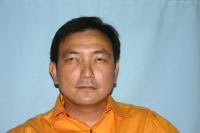The sky this afternoon is partly clear and yesterday's large hedgerow prominence has ejected out its plasma creating a huge eruptive prominence and a joy to view through a Ha equipped scope! AR2812 and remnant of AR2811 Sunspot Groups continues to show mild flaring activity as it approaches the western limb.
Tuesday, March 30, 2021
Monday, March 29, 2021
Solar Imaging Session - March 29, 2021
The sky this afternoon is partly cloudy and I have to fight with fast passing clouds to do solar imaging this late afternoon. AR2812 Sunspot Group still show some moderate flaring activity as well as remnant of AR2811 Sunspot Group. Several large group of prominences are visible on the SE , NW and SW limb. The NW limb prominence looks possible to grow larger tomorrow but will know fro tomorrow imaging session.
Sunday, March 28, 2021
Solar Imaging Session - March 28, 2021
The sky this afternoon is mostly cloudy but I was able to get a few shots of AR2812 and remnant of AR2811 Sunspot Groups in Ha wavelength late in the afternoon. Both of the groups shows flaring activity inside their core. Very small prominences can be seen around the limb of the Sun . I didn't image in white light wavelength.
Thursday, March 25, 2021
Lunar Imaging Session - March 25, 2021
The sky this evening is clear but seeing is not that good. I tested the focusing ring made by my fellow ALPer Raymund Sarmiento for me on my Canon EF 100-400mm f/4.5-5.6 IS lens on the Waxing Gibbous Moon with my ZWO ASI120MM webcam on Vixen GP-DX mount. I got to image the full disk as well as Tycho Crater Region and Mare Serenitatis Region with TV 2.5x Powermate.
Sunday, March 7, 2021
Solar Imaging Session - March 7, 2021
The sky this morning is clear and seeing is fair. There are 2 small sunspot groups on the Sun right now AR2806 which is a little bigger of the 2 groups while the other one is very very small AR 2807 Sunspot Group. AR2806 Sunspot Group is very active with flaring activity while 2807 Sunspot Group is very silent. I use my Canon EF100-400mm f/4.5-5.6 IS L lens set at 400mm this morning to do a test run on Daystar Quark Chromosphere Ha Filter using my regular 2" UV-IR Filter against a Daystar 63mm ERF (Energy Rejection Filter) on loan to me for testing by my astro friend. The ERF is mounted on the front of the Canon lens while the UV-IR filter is located inside and on the front of the Quark.
I use the Canon lens for this test because it has a 77mm lens while the ERF is 63mm diameter. I dont want to use the TV-101 refractor whih is a 101mm refractor as the difference in size will be biased in resolution. With 63mm aperture, one should expect a little lose in terms of resolution but the lesser heat factor might compensate. After I got the results, the difference between the 2 is very minimal. So I guess the factor here if you are wiling to spend a little more on the ERF to avoid heating up the scope internal tube, one ould expect to spend more or less around US$500 for one in that diameter. But I would say of you are using a much bigger scope in the 6 inch above, then the necessity of the ERF will be greatly valued. For scopes that are 4 inch or less in diameter, the UV-IR filter will suffice IMHO.
Aside from the 2 groups, there is also a nice large group of eruptive prominences in the SE limb. I was alos able to image the small AR2896 Sunspot Group in white light but seeing gone worst as well as roof obstruction ended my imaging session.
Below are Ha images taken with the 2" UV-IR filter installed on the front of Quark Chromosphere Ha filter.
Below are Ha images taken with the Daystar 63mm ERF filter in front of the Canon EF100-400mm L lens 77mm lens so the Sun light is reduced before it enters the lens tube toward the Quark Chromosphere Ha Filter,
Below are white light image of AR2806 Sunspot Group,












































